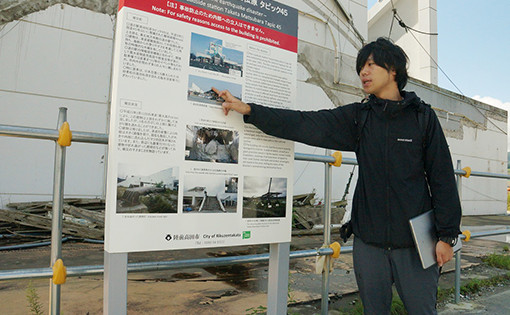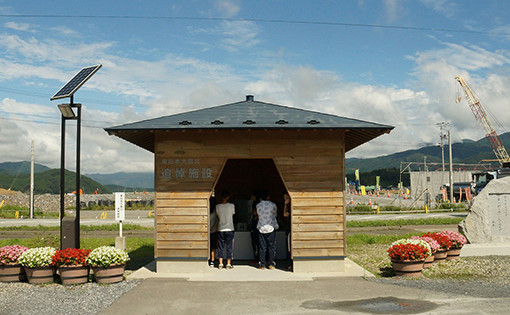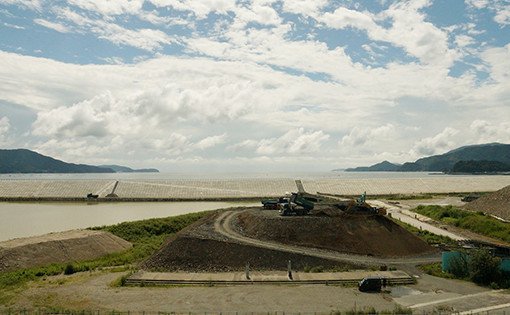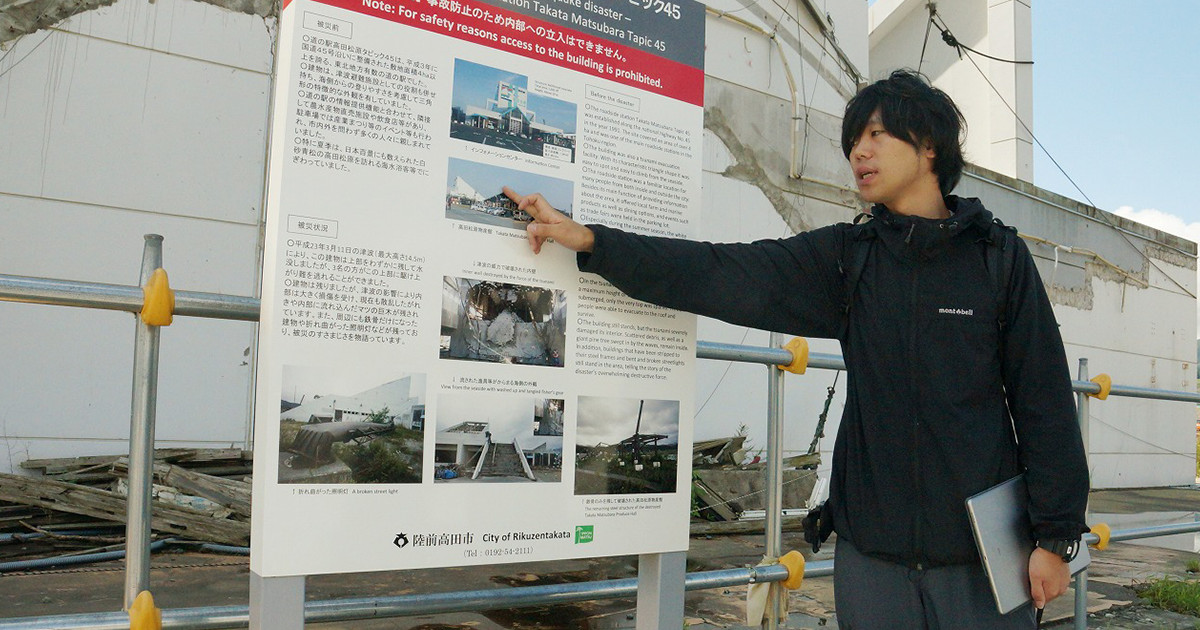Rikuzentakata:
Dreams Go Global
The Great East Japan Earthquake of March 11, 2011, shook the world.
Reconstruction in the stricken areas continues to this day. The other day,
I visited Rikuzentakata, the region subject to the most damage.
What most impressed me was the way the dreams and aspirations of this town have gone global.
Rikuzentakata is a coastal town in Iwate Prefecture that is adjacent to Ofunato, Sumita-cho, Ichinoseki and Kesennuma, located in Miyagi Prefecture.
I boarded the bullet train from Tokyo and, at Ichinoseki, transferred to the JR Ofunato Line to Kesennuma. I then got on the BRT at traveled at full speed in 4.5 hours to Rikuzentakata.
Hirotaka Koeto came to pick me up at the station. He works at Marugoto Rikuzentakata.
In Japanese, Marugoto means “the whole thing” or “all points.” The organization acts as a point of contact between Rikuzentakata and the world at large.
When the earthquake struck, Mr. Koeto was a graduate student at Iwate University.
He came here to volunteer and felt there was still more he could do.
After graduating, he decided he would launch a project to foster communication and exchange in and with Rikuzentakata in order to communicate to a wider audience what the situation is like here.

Mr. Koeto took me to the Takata Matsubara TAPIC45, a roadside station along National Route 45.
The remnants of the buildings here after the tsunami flooding subsided are referred to as “earthquake memorials.”
On March 11, 2011, the massive earthquake triggered a tsunami that, like a cruel beast, attacked the coastline, submerging the city in an instant and destroying city hall, the fire department, schools, and private homes. It leveled the terrain.
The skeletons of buildings remained, with some homes floating on the water. The tsunami surged its way inland.
The abandoned wreckage of Rikuzentakata was cleared, with the few remaining buildings acting as memorials of what once stood.
By preserving these remains, the locals want to convey to the next generation and beyond the power of tsunamis and the need to respect and understand the untamed aspects of nature.
At the front of the remains is a memorial burial site.
A bus carrying students on an observational field trip stopped here, and the passengers prayed for the repose of the victims of the tsunami at a flower altar.
Following the earthquake, Rikuzentakata was all but leveled, with 1,759 people dead or missing.
This accounted for 7.3 percent of the total population of the city.
Today, the whereabouts of 203 people remain unknown.
As we ascended the Takata Matsubari TAPIC45 roadside station, we could see a newly-constructed breakwater on Hirota Bay.
It is an imposing structure at 12.5 meters tall, 2 kilometers long, and shaped like the cross-section of a trapezoid.
It is located at the furthest point out from the coastline (100 meters) and acts as a twin-layer design alongside the existing 3-meter-tall breakwater.
The new breakwater cost approximately 30B JPY to construct.
Before the earthquake, there was a famous scenic area called Takata Matsubara that consisted of white beaches and pine trees. Iwate’s reconstruction project incorporates plans to rebuild both of these.
Takata Matsubara was numbered among Japan’s 100 finest views and boasted 70,000 majestic trees.
In the Edo Period (1603-1868), it acted as a windbreak, with white beaches and green pines as far as the eye could see in an unbroken expanse 2 kilometers long.
The famous ocean bathing areas made this a destination that charmed numerous travelers each year.
The tsunami produced by the earthquake besieged Takata Matsubara, leaving behind only one “miracle tree” strong enough to withstand the impact.
After the earthquake, this tree acted as a symbol of encouragement for the downtrodden people of Rikuzentakata.
While the tree was not initially felled by the tsunami, unfortunately, the foundation it rested on became increasingly salinated due to erosion from ocean water, causing the roots to become hyper-salinated and wither away.

To commemorate this tree, Rikuzentakata decided to install a metal rod inside the trunk so that it would stand up forever.
In July 2013, after being treated to prevent rotting or further decay, the “Miracle Pine” was restored to its upright position and became a symbol of Rikuzentakata.
After the earthquake, the newly-built Ofunato BRT Line opened the Miracle Pine Station, with a range of local specialty shops, ramen restaurants, cafes, and other attractions.
It is an integrated touristic facility referred to as “Ipponmatsu Chaya” (Pine Tree Teahouse). Kimuraya is a local sweets purveyor that sells souvenirs in packages stamped with the “Miracle Tree” emblem. In this way, you can find the tree as a symbol throughout the town.
Large trucks move back and forth constantly around the breakwater.
This March, construction began on the Takata Matsubara Tsunami Reconstruction Memorial Park at Takata Matsubara TACPI45, the roadside station.
It incorporates various earthquake memorial sites like the Miracle Pine, Kesen Middle School, and a youth hostel. This will became a nationally operated prayer and memorial facility when completed in 2020.
To the south of the breakwater, halfway down a mountain in Imaizumi Ward, I met with Nobutaka Sasaki, a man engaging in the construction project.
He told me that people from the Hokuriku, Tohoku, and Hokkaido regions can be found in the construction industry here.
Every day, 1,200 people get to work on what will be a lodging house with 800 rooms.
Mr. Sasaki began working in the area in December 2012. Through March 2013, they were still clearing rubble.
Then, they dug up earth and stones in Imaizumi to be used in the land reconstruction in Rikuzentakata.

Mr. Sasaki is a part of the Rikuzentakata Shimizu Joint Venture, a joint reconstruction project of five firms seeking to rebuild Rikuzentakata.
He pointed to the distance and said,
“This mountain was once 120 meters in size, but now it has been shaved down to 45 meters. The embankment here is to be used for residential space. The plot has already been zoned and sold.
Over there, in the future, Takata Elementary School will be built. The view will definitely change after the athletic field, baseball stadium, track & field track, and tennis courts are built up.
In a year and a half, Takata will be rebuilt. Imaizumi will take two years, but it should be ready in time for the 2019 Rugby World Cup and 2020 Tokyo Olympics.

In the offices of the temporary building for the Rikuzentakata City Hall, Manabu Sasaki of the Rikuzentakata Reconstruction Bureau told me that 8,030 households were affected by the disaster, or 99.5% of all households The city therefore created the Project for the Promotion of Transition to Disaster-Proof Areas and the Public Disaster Reconstruction Housing Project.
The former sees the city building a residential district on a plateau and having victims purchase or rent land there to rebuild homes in the new zone.
The costs of moving and construction are covered through residential loans, with the city subsidizing the interest.
Where victims request it, the city can buy back the land on which they formerly lived.
Currently, there are thirty sites slated for construction in the new residential zone, with 28 already complete.
The latter project sees the city building public housing and offering it to victims. They originally forecasted 1,000 households, but it was contracted to 895 by popular request.
As of June 30, 2017, 806 households and 2,027 people still live in emergency temporary housing.






